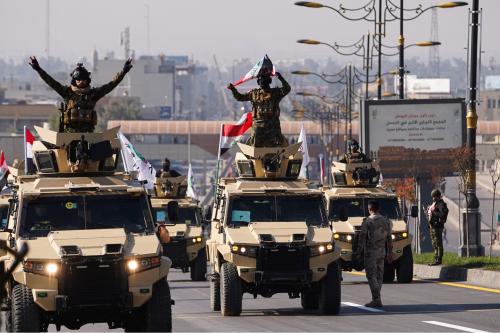In December 1987, Ronald Reagan and Mikhail Gorbachev signed the treaty on intermediate-range nuclear forces (INF), a landmark agreement that banned an entire class of U.S. and Soviet nuclear weapons. The agreement put the brakes on a spiraling arms race, but this week brings worrying news that — just over two decades later — Russia may be actively going back on its word. Questions have arisen as to whether Russia has tested missiles in violation of the treaty’s terms, most recently in a Jan. 30 story in the New York Times. Some claims are spurious; others appear more serious.
If Moscow has developed a prohibited INF missile, it will have implications for U.S.-Russia arms control. But it will have even more important implications for Russia’s relations with its neighbors in Europe and Asia, including China.
The INF Treaty banned all U.S. and Soviet land-based ballistic and cruise missiles with ranges between 500 and 5,500 kilometers (300 to 3,400 miles). When the treaty’s reduction period concluded in June 1991, 846 American and 1,846 Soviet missiles had been eliminated, as well as their associated launchers and other equipment. The treaty’s intrusive verification measures pioneered provisions incorporated into the 1991 Strategic Arms Reduction Treaty (START I).
There have been periodic charges — often made by critics of the Obama administration’s arms control policy — that Russia has violated the INF Treaty’s terms. (Russia took on Soviet treaty obligations after the USSR’s collapse at the end of 1991.) Up until now, most charges have focused on the RS-26 ballistic missile. Those charges have no basis.
Critics have expressed concern that the RS-26 has flown to intermediate ranges, which apparently it has. But the Russians have also tested the RS-26 to ranges greater than 5,500 kilometers. That makes it an intercontinental ballistic missile (ICBM) subject to the limits of the 2010 New START agreement. New START defines ICBMs as land-based ballistic missiles “with a range in excess of 5500 kilometers,” whereas the INF Treaty bans land-based missiles with ranges “in excess of 500 kilometers” but “not in excess of 5500 kilometers.” These definitions clearly make the RS-26 an ICBM.
It is a simple fact of physics that an ICBM can be flown to a range of less than 5,500 kilometers. When concluding the INF Treaty, the Reagan administration well understood that fact. Indeed, U.S. officials assumed that the Soviets would plan to use some of their ICBMs against time-urgent targets in Europe and Asia as they eliminated their INF missiles.
Less information is available regarding a more recent charge, that Russia has tested a ground-launched intermediate-range cruise missile. This appears more serious. Acting Undersecretary of State Rose Gottemoeller told NATO allies in mid-January about the missile and U.S. concerns, which Washington has been raising with Moscow — thus far, apparently, to no satisfactory end.
Barack Obama’s administration appears reluctant to call this a treaty violation, at least publicly. It may wish to allow more time to resolve the question, or push Moscow on other matters. Such issues have been settled in the past, often through private diplomacy. The Reagan administration for years pressed its concern that a large phased-array radar system in central Siberia violated the Anti-Ballistic Missile Treaty; the Soviets ultimately agreed to tear it down.
It is little secret that some quarters in Moscow have long had objections to the INF Treaty. In February 2007, Russian President Vladimir Putin expressed concern that Russia and the United States were barred from having INF missiles while other countries could have them. At the same time, Sergei Ivanov, then minister of defense and now chief of Putin’s presidential administration, called the INF Treaty a mistake. More recently, however, Russian officials have seemed more comfortable with the treaty. In May 2012, the chief of the Russian General Staff explicitly ruled out withdrawal.
If the charge regarding the ground-launched cruise missile is true, it will have implications for U.S.-Russia arms control, bringing into question Moscow’s good faith in meeting treaty obligations. Capitol Hill critics wasted little time in using the New York Times story to challenge the administration’s entire approach to arms control, even with regard to the Iran nuclear deal and arrangements to destroy Syria’s chemical weapons. While there may be a serious compliance issue regarding the INF Treaty, the sides appear to be smoothly implementing New START. The Russians already meet two of the treaty’s three limits on strategic forces — even though those limits do not kick in until February 2018.
An INF Treaty violation would add yet another problem to a broader U.S.-Russia agenda that already has its fair share of problems. It is an issue that the administration nevertheless has to pursue seriously, as it apparently is doing with Moscow.
An intermediate-range cruise missile would have more important implications for Russia’s neighbors. Such a weapons system would be explicitly designed to hold at risk and strike targets in Europe and Asia.
Russia’s relations with Europe have soured recently, as concerns have grown over Putin’s authoritarian tendencies, Moscow’s aggressive behavior in the post-Soviet space, and the monopolistic practices of energy giant Gazprom. The Jan. 28 EU-Russia summit was cut to just three hours. EU leaders — including in Germany, which traditionally has strived to maintain a friendly relationship with Russia — will hardly welcome the prospect of new Russian nuclear weapons targeting their countries.
A Russian intermediate-range cruise missile would raise concern in Asia as well. It could cool the recent warming trend in Russia-Japan relations. And it would do little good for Russian relations with China. Beijing often plays the role of Moscow’s partner on international questions and never appears on the official Russian list of security concerns. But few things worry the Russian leadership more than the growth of the Chinese economy and the concomitant buildup of Chinese military power. Indeed, if there is a new Russian missile, Beijing’s rise may well be the motivating factor.
New intermediate-range nuclear arms would spark concerns among all of Russia’s neighbors, especially as the Russian military already has some 4,500 nuclear weapons — well more than 10 times the number of nuclear weapons that any country (other than the United States) has. Moscow will not have an easy time explaining this. If the reports of the new cruise missiles are true, the Russians are buying themselves more than just a new problem with Washington.
This article originally appeared in Foreign Policy.
The Brookings Institution is committed to quality, independence, and impact.
We are supported by a diverse array of funders. In line with our values and policies, each Brookings publication represents the sole views of its author(s).



Commentary
Op-edThe Moscow Missile Mystery: Is Russia Actually Violating the INF Treaty?
January 31, 2014